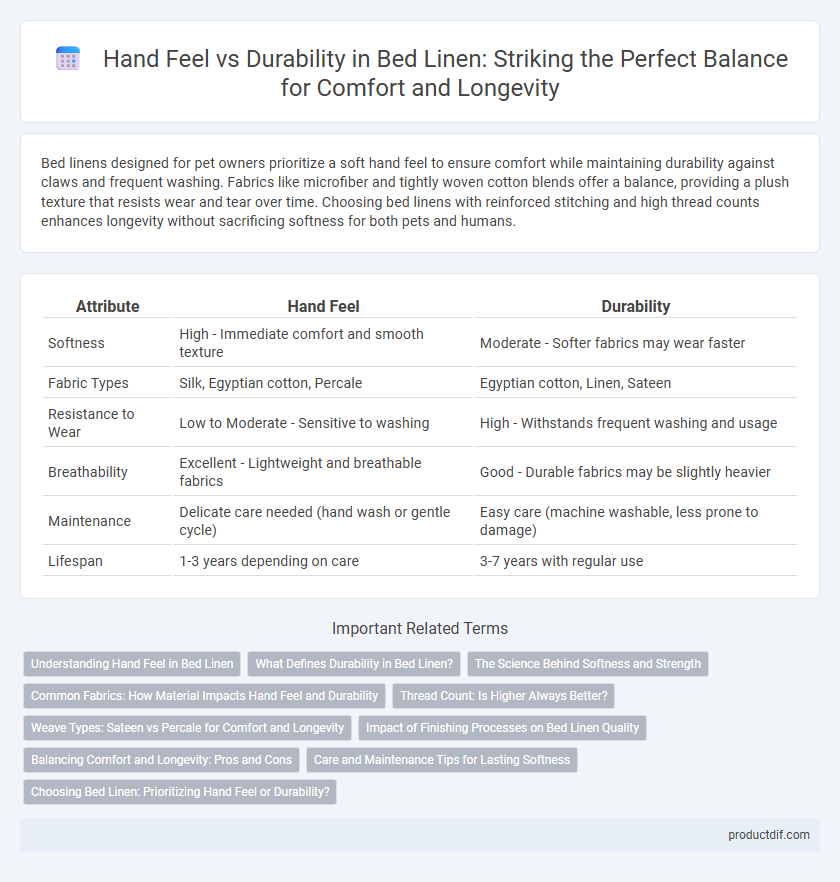Bed linens designed for pet owners prioritize a soft hand feel to ensure comfort while maintaining durability against claws and frequent washing. Fabrics like microfiber and tightly woven cotton blends offer a balance, providing a plush texture that resists wear and tear over time. Choosing bed linens with reinforced stitching and high thread counts enhances longevity without sacrificing softness for both pets and humans.
Table of Comparison
| Attribute | Hand Feel | Durability |
|---|---|---|
| Softness | High - Immediate comfort and smooth texture | Moderate - Softer fabrics may wear faster |
| Fabric Types | Silk, Egyptian cotton, Percale | Egyptian cotton, Linen, Sateen |
| Resistance to Wear | Low to Moderate - Sensitive to washing | High - Withstands frequent washing and usage |
| Breathability | Excellent - Lightweight and breathable fabrics | Good - Durable fabrics may be slightly heavier |
| Maintenance | Delicate care needed (hand wash or gentle cycle) | Easy care (machine washable, less prone to damage) |
| Lifespan | 1-3 years depending on care | 3-7 years with regular use |
Understanding Hand Feel in Bed Linen
Hand feel in bed linen refers to the tactile sensation and softness experienced when touching the fabric, which significantly influences comfort and sleep quality. It depends on fiber type, thread count, weave, and finishing processes that affect smoothness and breathability. Understanding hand feel helps consumers balance comfort preferences with durability requirements to select linens that maintain softness over time.
What Defines Durability in Bed Linen?
Durability in bed linen is defined by the quality of fibers, thread count, and weave type, which determine the fabric's resistance to wear and tear over time. High-quality materials like long-staple cotton or linen fibers enhance strength while maintaining a soft hand feel. A balanced combination of durability and comfort ensures bed linens remain smooth and intact through repeated washing and use.
The Science Behind Softness and Strength
The science behind bed linen softness and strength lies in fiber type, weave structure, and thread count, where long-staple cotton fibers like Egyptian or Pima enhance hand feel without compromising durability. Tighter weaves such as percale offer crisp strength but a less plush hand, whereas sateen weaves provide a silky, soft touch while maintaining moderate durability. Advanced fabric treatments and mercerization also improve softness by aligning fibers and increasing tensile strength, balancing comfort and longevity in high-quality bed linens.
Common Fabrics: How Material Impacts Hand Feel and Durability
Cotton bed linens offer a soft, breathable hand feel while maintaining medium durability, making them ideal for everyday use. Linen fabric provides a textured, crisp hand feel with superior strength and long-lasting durability, perfect for those seeking resilience and natural fiber benefits. Polyester blends combine smoothness and wrinkle resistance with increased durability, offering a practical choice for easy-care bedding that withstands frequent washing.
Thread Count: Is Higher Always Better?
Thread count often influences the hand feel of bed linen, with higher counts typically offering a softer, smoother texture due to finer yarns and tighter weaves. However, extremely high thread counts can lead to reduced durability as densely packed fibers may weaken fabric strength and breathability. Balancing thread count around 300 to 500 ensures optimal softness while maintaining bed linen longevity and comfort.
Weave Types: Sateen vs Percale for Comfort and Longevity
Sateen weave offers a buttery-soft hand feel due to its longer floats, making it ideal for those prioritizing comfort and a luxurious touch. Percale weave, characterized by a tighter plain weave, provides superior durability and a crisp, breathable texture that withstands frequent washing. Choosing between sateen and percale depends on whether softness or long-term resilience is the primary concern for bed linen performance.
Impact of Finishing Processes on Bed Linen Quality
Finishing processes such as mercerization, calendaring, and enzyme treatments significantly enhance the hand feel of bed linen by smoothing fibers and increasing softness without compromising durability. These treatments improve fabric strength and resistance to wear, ensuring longevity even after multiple washes. Optimizing finishing techniques balances luxurious tactile comfort with robust durability, elevating overall bed linen quality.
Balancing Comfort and Longevity: Pros and Cons
Hand feel in bed linen, often characterized by softness and smoothness, enhances immediate comfort and sleep quality but may indicate delicate fibers prone to wear. Durability ensures long-lasting use and resistance to frequent washing, typically found in materials like percale or sateen weaves, yet can sometimes sacrifice the plush feel. Balancing comfort and longevity involves selecting fabrics such as high-quality cotton blends or linen that offer a soft touch without compromising strength and lifespan.
Care and Maintenance Tips for Lasting Softness
Maintaining bed linen's hand feel and durability requires gentle washing with mild detergents and avoiding harsh chemicals that degrade fibers. Using cold water and air drying or low heat tumble drying preserves softness and prevents fabric weakening. Regularly rotating sheets and promptly treating stains ensure longevity and sustained comfort.
Choosing Bed Linen: Prioritizing Hand Feel or Durability?
Choosing bed linen often involves balancing the softness of hand feel against long-lasting durability. Materials like Egyptian cotton offer exceptional softness but may require careful maintenance, while percale weaves deliver durability and crisp texture ideal for frequent washing. Prioritizing hand feel enhances comfort, but selecting durable fabrics ensures sustained quality and value over time.
Hand Feel vs Durability Infographic

 productdif.com
productdif.com